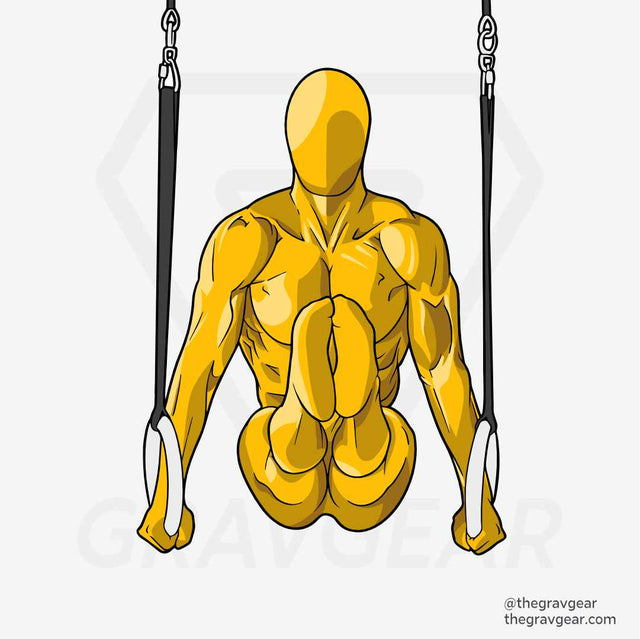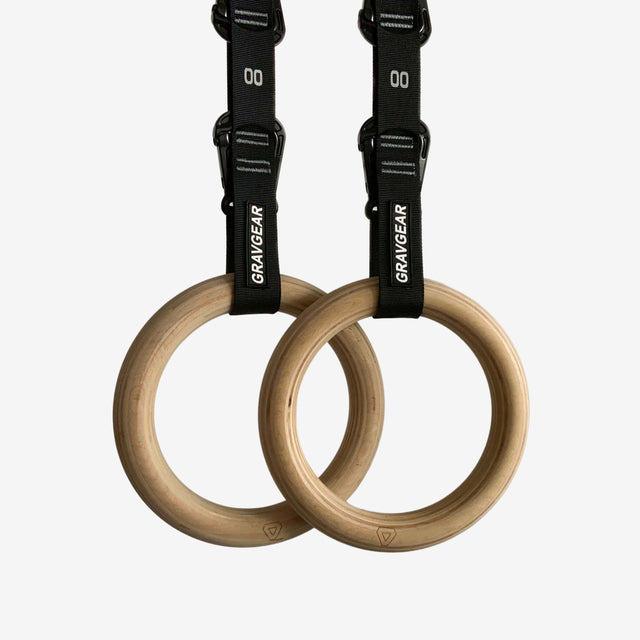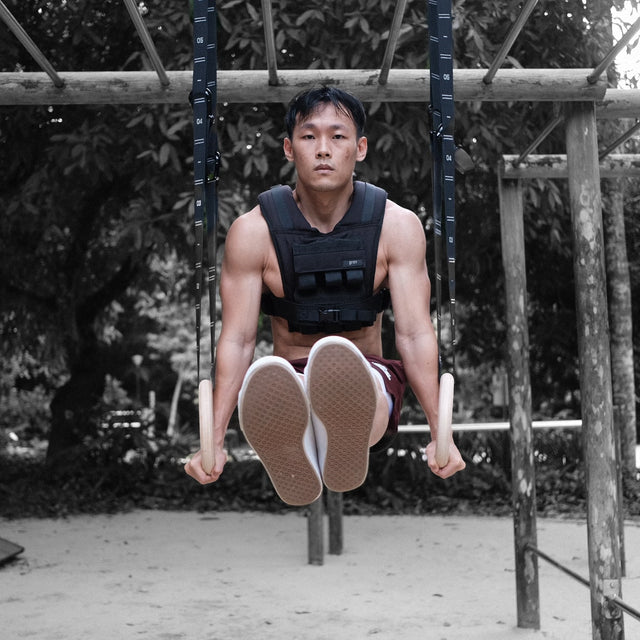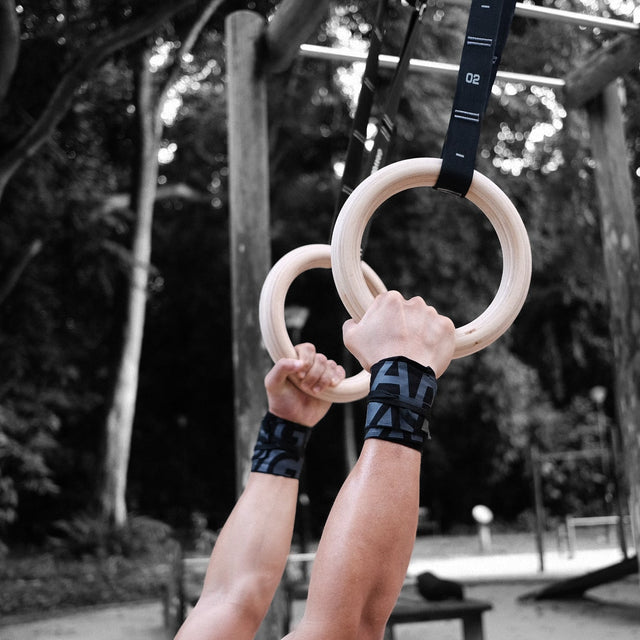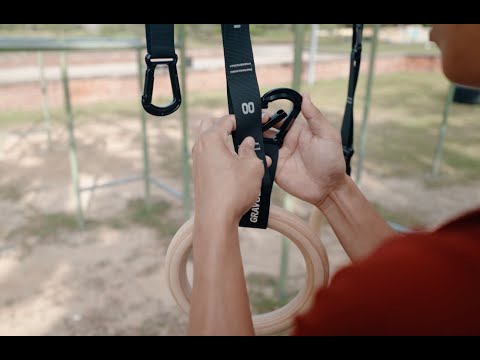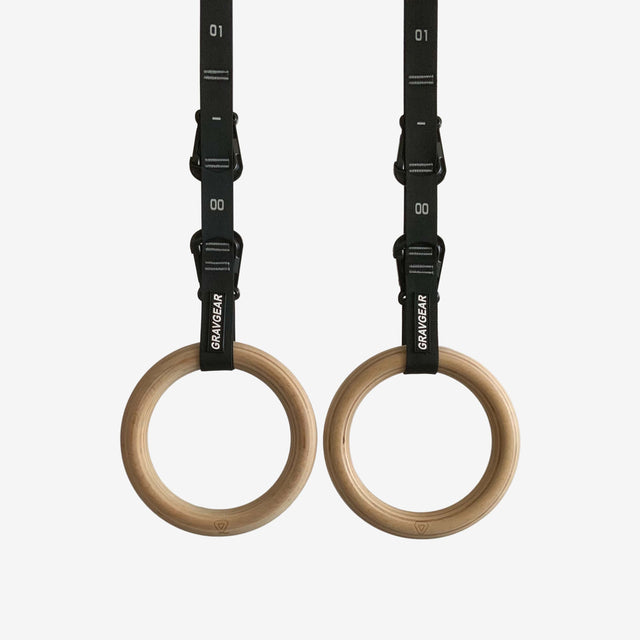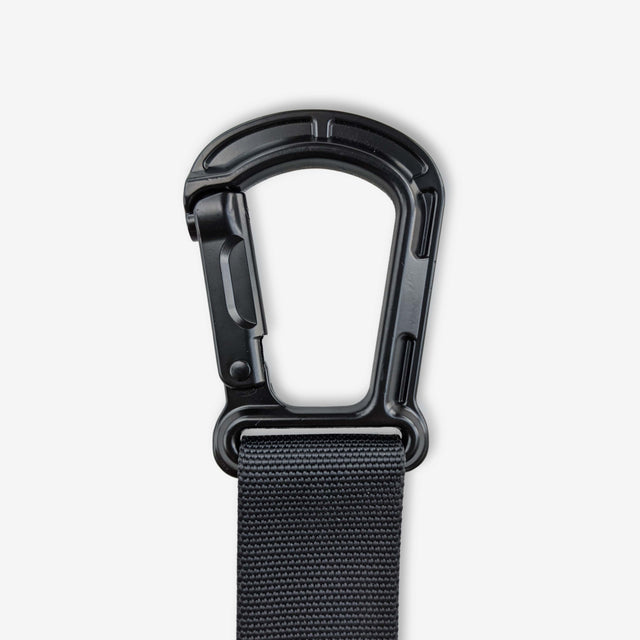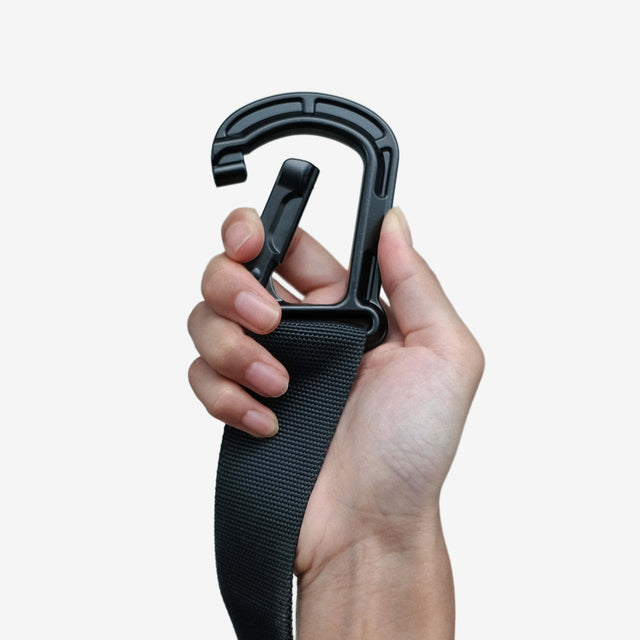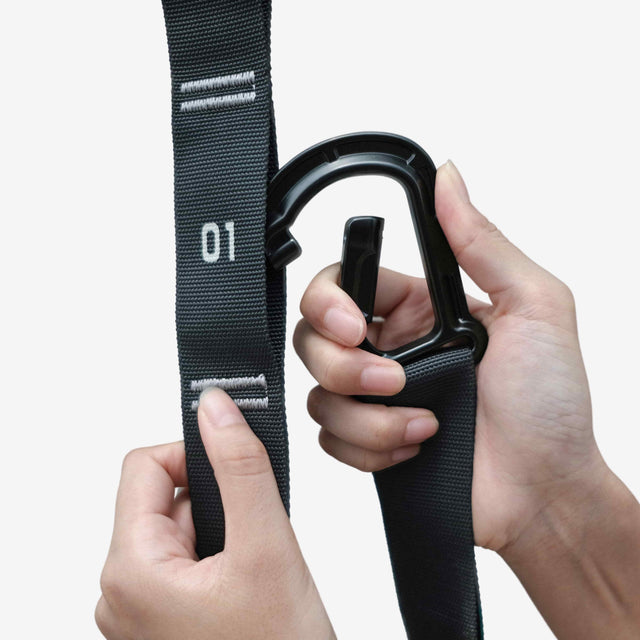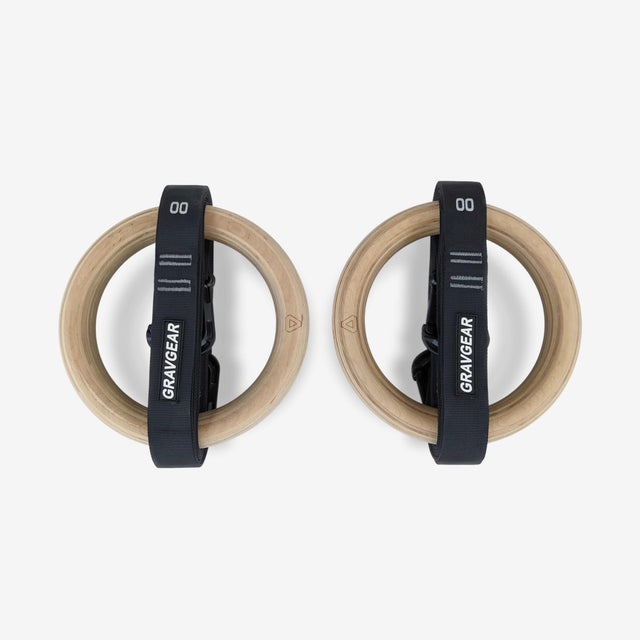Gain Insane Strength With Gymnastic Rings (All You Need To Know)
Gymnastic rings are a great way to build strength, agility, and balance. They can be used for pull-ups, dips, leg raises, and many other exercises. Gymnastic rings have been around since the 1800s but they became more popular in recent years with CrossFit and calisthenics enthusiasts who use them as an alternative to expensive equipment at their gym or home. Due to their popularity, you will find many different types of gymnastics rings on the market that vary in quality and price.
In this blog post we discuss:
- Gymnastic ring workout benefits
- What are the best gymnastics rings?
- How do I set up my own rings?
- Beginner gymnastic ring training
- Ring Pull-up
- Ring Archer Pull-up
- Ring Dips
- Ring L-sit Dip
- Ring Push-up
- Frequently asked questions
- Gymnastic rings are awesome
Gymnastic ring workout benefits
If you are serious about dominating your bodyweight fitness game, gymnastic rings are a must-have.
The two rings hanging from the high anchor point might seem insignificant, but they can be the most punishing fitness too you ever use for the first time.
Rings make all workouts instantly harder

Gymnastic rings are unstable by design, whatever you can perform without issue with the static bars, will be ten times harder on the rings.
This instability forces your stabilizing muscles that you never knew existed to work in overdrive, giving a full-body workout that builds muscle and endurance faster than any equipment out there. They challenge all of your major muscle groups at once.
Gymnastic rings provide a very small surface area to balance on and the instability makes it easier for you to push your muscles. This allows you to work with higher intensity, making them great for building strength and muscle like no other equipment can offer.
Rings workouts are friendly to joints

The free-hanging rings allow for a natural range of motion.
They don’t have the same restrictions as bars and dumbbells, allowing your joints to move freely through their full range of motion. You can load up on heavier weights without worrying about injury or the wear and tear on your joints from years of strength training with traditional equipment.
Take pull-ups as an example, our wrists actually need to pronate (turn inward) and supinate (turn outward) as we pull ourselves up. With straight bars, our wrists are completely fixed in one position the whole time. With rings, your wrist can move naturally through its full range of motion throughout the set without any limitations.
Progression overload becomes easier with rings
How to progress efficiently in calisthenics has been a headache for many. You might be running of out movement you can practice gaining bigger strength and muscle.
With rings, you can perform the same exercises that you have been practicing for years, but just by changing your grip position.
Rings allow the user to vary their grip widths and hand positions during an exercise thus providing different levels of resistance. For example, a wider than shoulder-width ring pull up is easier than a close underhand grip or narrow neutral one arm at a time.
Compatible with all calisthenics exercises

All calisthenics exercises can be done on gymnastic rings.
In the same way that you would use a barbell for squats, bench presses, and deadlifts, gymnastic rings allow you to perform all sorts of compound exercises as well as single-joint movements.
In fact, calisthenics shines when it was performed on the gym rings.
Gymnastic rings are durable and affordable
You can find quality pair of gym rings on the market between 50-100 dollars. There are even plastic rings which you can get for around 30 dollars (but they are bad, don't get those).
Carefully crafted wooden gym rings are generally under 150 bucks (see recommendation below) and they will last you forever. You can hardly find any other fitness equipment with a higher return on investment than gymnastic rings.
Gymnastic rings are lightweight and portable
You can hang the rings anywhere and their small size makes them easy to pack.
They also don’t take much space when they are in storage, which makes it the ideal equipment for tiny spaces or if you travel a lot.
What are the best gymnastics rings?
There are many models and brands on the market.
Most of them do their job well, but if you want to get great quality rings for a good price, you have to go with what the professional uses -- wooden rings.
Wooden rings -- The best gymnastic rings

Wood is a perfect material for gymnastic rings. There is a reason Olympic gymnasts are only using them in gym or competition.
It’s strong, durable and it has the best grip-to-weight ratio -- making wooden rings by far the most popular option on the market. Wooden gymnastics equipment also has unbeatable durability -- they will last you a lifetime if they are properly taken care of.
Wooden rings offer the best grip because of their textured surface. They are also safer than metal/plastic rings because they don't slip so easily. There is no need for chalk as the wooden property tends to absorb slight sweat and further increase the grip.
What can make a wooden ring better? Wooden rings with carabiners straps! You can now adjust the height of the ring to the perfect same level within minutes.
Metal rings for the most durable pair of rings
Metal rings can last for decades but they are also the most expensive. You will mostly find them in the outdoor local park because metal is the most weather-resistant material.
Metal rings are very strong and made from heavy-duty materials such as aircraft-grade aluminum, stainless steel, or titanium alloy. However, this also means they will be heavier than the classic wooden rings, by miles.
Metal rings are often coated in smooth powder coating that gets slippery with the least sweat from your palm. A pair of rubber gloves or palm chalk is necessary to go with metal rings.
That said if you are about to invest in a great pair and use it mostly door, get the wooden rings.
Plastic rings -- Don't get these
If you are a total beginner who wants to get started with rings, you can probably give plastic gymnastic rings a try. But upgrade the material as soon as you are comfortable with the ring workout.
Plastic gymnastic rings are the worst because they are not durable. No matter using they are indoor or outdoor, plastic tends to break down over time due to the UV light and humidity in the air. The last thing you want is to perform difficult moves on them and they break a surprise on you.
Plastic rings are not safe either as they tend to slip easily. They also have a cheap look and feel, which is definitely not good for professional athletes who train on the equipment every day.
They are often too light and flimsy -- making them hard to use even for the most basic gymnastic exercises such as pull-ups or dips. They also have terrible grip because they get slippery easily, which makes it dangerous when you work out on bars set high from the ground.
Stay away from plastic rings, they are not comfortable to use and is a time bomb waiting to explode.
How do I set up my own rings
Setting up your own rings is very simple and doesn't require much work, to begin with. All you need is a pair of rings and someplace high enough to hang them.
Places to hang gymnastic rings
All you have to do is hang them from two sturdy anchor points:
- Tree branch: You can hang them from a tree branch if you have one outside. Pick the strongest tree and choose the branch that seemingly is not dead. Deadwood is fragile and tends to break easily. Branches that are parallel to the ground are best as they would ease your adjustment on the rings.
- A metal bracket on the wall: If you have a workout room at home, you can get gymnastic rings brackets and install them on the walls so it's easy to hang up the equipment when not in use. Make sure the mount is installed on reinforced concrete with proper bolts.
- Pull-up bars: Most ideal place to hang your gymnastic rings are they are high and sturdy enough to support your weight and the equipment. Monkey bars can are the equivalent of a pull-up bar and they are found in playgrounds.
- Doorway: This is not as ideal compared to the above options. But doorway is the most accessible in most places. It can even be done while you are in a remote hotel. Anchor your ring straps on the outside of the door over the top. Use soft and big objects like a towel or yoga brick and wrap the strap around. Close and lock the door while you are on the inside, you have sturdy anchored rings to work out now.
How far apart to space the rings?
According to the guideline from International Gymnastics Federation, still, rings are 50cm apart (20 inches). This is pretty much the standard ring spacing for performance and competitions.
However, you can play around with different settings depending on your goal. If building strength is your priority, set up the rings at shoulder-width apart so you have to muscle through more range of motion.
You can set the rings slightly wider if you find your arms constantly rubbing against the straps and it might get irritating.
If you want to make things harder, setting the rings wider than your shoulder will instantly make everything a lot more difficult.
How high off from the ground is to hang gymnastics rings?
The higher up your rings are from the ground, the more challenging it would be. For most exercises such as dips and pull-ups, the ideal height of the ring strap is at shoulder height.
It also depends on your setup. If you plan to install the rings one-off and leave it there permanently (such as in a gym), install them as high as possible. In another word, use most of the length of the straps.
If you need to keep changing the rings for different heights or keep it up when you are done. Set the rings at the point where you can easily access them. Great example and a pull-up bar or mounting points on the ceiling.
Different heights for different gymnastic rings workout
We can split three different heights to hang the rings, depending on the rings and your skill levels.
Above the head height
This is great for exercises that your body stays below the rings all the time, such as:
- Pull-up, chin-up
- Ring L-sit with a pronated grip
- Front lever, back lever
- Dead hang
- German hang
This height is best for a move where your body will rise beyond and go under the level of the ring. Typical examples are:
- Dips
- Muscle-ups
- Skin-the-cat
- Ring L-sit with the body above the rings
- Cartwheel
- Support hold
The waist-level height is also great for workouts where you put your feet on the ground. Many easier progression skills fall under this category:
- Australian pull-up
- Inverted body row
- Ring butterfly, ring fly
- Ring face pull
- Ring bicep curls
- Pelican curl (biceps killer)
- Ring ab-rollout
Ground or feet height
This is not the typical height you will see people use to hang their rings. But things can get interesting here. You can do almost all the moves which you do on the ground, on rings with this height.
For the most difficult setting, set the rings as close as possible to the ground. Here are some exercises you can do:
- Ring push-up: Nothing has changed except your hands are not placed on the stable ground anymore. You will need to engage hard on your shoulder blades and core on every rep.
- Ring ab-rollout: You can perform this with higher rings but it gets harder now.
- Ring fly: The best exercise to build up your shoulder girdle. You can even go further by lowering the rings to ground level and try ring push-up then fly together for a combo.
Instead of making things harder, lower rings height can also make some exercises safer to practice. One great example is the gymnastics rings handstand. Practice it on above head level is intimidating, and all it takes is one fall to break your wrist. Lower the rings to ground level then practice it there is much safer.
Beginner gymnastic ring training
Gymnastic rings are an excellent tool for building strength and muscle quickly.
Unlike weights, gymnastics rings allow you to perform a much wider variety of exercises that are more efficient than those performed with traditional weight lifting equipment.
Ring Pull-up
You probably have done a pull-up in the normal static bar, but doing it on an unstable gymnastics ring is another game!
You will need more engagement from your core to stabilize your body from the free-hanging rings. Or you will find yourself swinging back and forth due to the pulling motion.
After setting up the gym rings, adjust the rings to a height that is reachable when you are standing with your arms fully extending to the sky.
That way, you are making sure you have full room to extend your legs at the bottom.
- Start by hanging from gymnastic rings with a pronated grip, thumbs around the gymnastics ring and palms facing away from you.
- Pull yourself up to get your chest as close as possible to the gymnasts ring in front of you then hold for a second to stop the momentum.
- Lower down slowly to return to start position with straight arms. The rings should turn out when your body reaches the lowest point.
The key is to keep your shoulder blade and core engaged all the time in the process so you can do the movement in a clean manner.
Ring Archer Pull-up
Archer pull-up is a great workout that challenges your one arm's stability and strength. You should be able to perform at least 5 ring pull-ups before trying this.
- First, hang from the ring with retracted shoulder
- Pull your body up as if you are performing a normal pull up
- Once you are at the top, keep the most tension at one hand and extend the other hand until the elbow is straight out
- Then, keep the extended arm and hand back to pull-up position in controlled manner
- Lower your body to initial dead hang position
- Repeat by performing another set of archers pull-up with another arm.
Try to keep your chest up and back straight. Don't releasing tension from the gymnastics rings until you are done with the set.
Ring Dips
Want to get your arms fired up in no time? Do dip on the rings!
These gymnastic ring exercises work your shoulders, chest, and triceps. And it’s a great way to build more upper-body muscle and strength in general (especially if you use the rings for pull-ups as well).
You can also do dips on parallettes or push up bars. Gymnastics rings are superior because they force you to engage your core muscles too.
- To start with gymnastic ring dip: place the gymnastics rings about shoulder width apart from each other (you may need to experiment with different distances). Wider distance is harder but your arm don't get to rub against the straps which can be a little bit irritating.
- Grab onto both gymnastics rings and lean back until both the rings are beside your torso. Straighten your legs so they are supporting some of your weight but remain bent slightly if this feels comfortable.
- Lower your body slowly until your chest are touching the rings. Hold for a second.
- Push back up to the start position.
- Once you at the top, straighten your elbows and turn out the rings
If this feels too hard, you can also bring gymnastics rings close together for a easier workout. The closer gymnasts ring is easier as it requires less effort.
Ring L-sit Dip
L-sit dip is essentially a more advanced version of dips on gymnastic rings. Here's what it looks like:
- At the top position, like normal dip with gym rings, start with holding on top of the rings with straight elbows. Turn the rings out so they're perpendicular to your body with palms facing out.
- Keep your feet forward and toe pointing straight, raise them up until parallel to the ground. You can bent the knee to make this part easier. Your hip should naturally move backward to compensate the leverage of legs in front of you.
- Now, lower yourself down as slowly as possible until a 90-degree angle is made in your arm joints. You will find your leg cannot maintain the parallel position to the ground while lowering down your body, and it is fine.
- Push yourself up by extending at the elbows for one repetition.
Ring Push-up
Push-up on rings is the best way to level up this fundamental workout in a fun an efficient way. You get to challenge your arms and shoulder stability a lot more than doing push-up on the floor. You can also stimulate your chest more by going pass the rings level when lowering down.
- Firstly, set the gymnastics rings at a level that is close to the ground. To make this workout accommodate to beginners, just shorten the straps and make the gymnastic rings higher.
- Secondly, grab the rings and get into plank position. Keep the core engaged and straight at all times.
- Thirdly, lower yourself with controlled motion. Stop and hold at the lowest point.
- Fourthly, when you get back to the plank position, go past the gymnastics rings level and pull down with your hands in a slow-motion for an intense stretch on pectoral muscles. That’s one rep of push-up on gymnastic rings! Repeat this sequence again by going through step three until you have done ten reps on each side.
Frequently asked questions
What muscles do gymnastic rings work?
It depends on the workout. There are certain muscle groups gymnastic rings workout trigger the most.
Abdominal muscles as the biggest stabilizing muscles group in our body play the most important role in keeping our body stable. Want it or not, you will have to engage your abs throughout all the movement when you are on the rings.

The forearms and wrist are the direct contact points on the rings. You will grow a strong and thick forearm as your grip strength increases. If you use a false grip, your wrist will get stronger and more flexible.
The triceps, lats, and pectoral muscles are activated when you pull yourself up on the gymnastic rings. This will require a lot of energy from your arms as well.
How to grip the rings?
You can grip the rings with a regular grip or better yet, the false grip.
Instead of grabbing the rings at the ring's bottom with most of your fingers, grab it across your palm base (hypothenar) to the area between the thumb and index finger (purlicue).

This way, the main contact point would be your hypothenar. And that ensures your wrists are always on top of the rings.
The false grip allows you to move around the rings without changing grip position. Muscle-up is one of the examples.
Do ring workouts build muscle?
Yes, they do. Even more so than a regular workout on a static surface. Ring workouts are effective at building muscle because your body will be forced to adapt to the unstable condition when holding the ring and moving around on it at different angles that naturally occur in any handstand or pull-up movement.
Many have been building amazing muscle mass with calisthenics and ring workouts are part of their primary routines.
Do rings work shoulders?
Ring workouts can be as powerful as shoulder workouts because it involves contracting and using shoulder stabilizers in a variety of angles and planes of motion. You don't get to experience those with most other training methods.
The shoulders are the main driver in positioning our body on the rings. Iron cross, Maltese, ring planche are all accomplished with incredible strong shoulders.
Can you train rings every day?
Compare to static pull-up bars, gymnastic rings are a lot more forgiving to the joints.
If you plan on training pull-ups on a daily basis, the wise choice is to go with gymnastic rings. Because it allows your wrist to rotate in a natural direction.
However, if you just starting to work out with rings. Gives your body some time to rest and adapt. Avoid over-training before your body is ready.
Is gymnastic rings workout dangerous?
No, gymnastic rings are actually very safe. Most injuries occur during the movement transition from one position to another when your muscles are fatigued and you make a mistake in form or forget about your stabilizing muscle groups that should be activated throughout all movements.
That’s why it is important to learn techniques
Are rings good for hypertrophy?
Absolutely. Rings are one of the best tools for developing muscle mass. They're especially good at targeting small stabilizing muscles that you typically don't hit when working with static pull-up bars or other types of equipment.
That's the reason you can see most of the gymnast are buffed with great physiques. They didn't specifically train for muscles, it just come as by product of training for strength and spending most of their sessions on gymnastic rings.

You will always have to engage more muscles when you are on the rings for stabilization. This also helps a ton in muscle-mind connection and in your ability to balance and control the body.
How do you take care of gymnastic rings?
When not in use, keep the wooden gym rings in a dry and cool place. Avoid exposing the rings to direct sunlight or concentrated moisture for an extended period.
Before you start training with them, always make sure that there is no dirt or anything on the rings and your palm. Wooden rings can easily be scratched by dirt. Sand the rings with fined graded sandpapers to remove minor scratches.
If your wooden rings are damped, never blow them dry because they can break the wood. Just hang it in a cool place and it should be dry again the next day.
How do you balance a ring?
To balance the ring on a support hold position, place your palm on it and lean forward. To make balancing easier, you can also put one foot in front of another for support or move hands closer to each other.
Grip the rings tight and keep them right beside your body. Your body, the arms, and the rings straps should be connected to each other for maximum stability. You can also set the distance between rings to a narrower one.
You should be able to hold this position with ease after a couple of sessions of dedicated practice.
How do you warm-up before a gymnastics ring workout?
The best way to warm up the rings is by doing simple drills. Static holds are wonderful for waking up the muscles because they don't put too much strain on elbows or other joints. German hang on the rings is a great warm-up for the shoulders and multiple joints.

Or you can do whatever drills that are easy for you. Do a couple of ring rows, ring push-ups, and inverted hang, with the rings close to your body (easier).
You can also do some shoulder circling, arm swings, and wrist circles to warm up your shoulders.
Gymnastic rings are awesome
Gymnastic rings are a fantastic way to challenge your body and improve strength in areas you wouldn't normally train by lifting weights. If you’ve been looking for a way to spice up your workouts, start training with a pair of gymnastic rings. They are an inexpensive and versatile workout tool that can be used at home or in the gym. Plus, they are really fun!

